Enhancing GNSS PPP Algorithms with AI: Towards Mitigating Multipath Effects †
Abstract
1. Introduction
2. Materials and Methods
2.1. Feature Engineering
- SNR: It is an important metric that helps determine the quality of a received signal against the background noise level. The original meaning of this term is the ratio of the power of the signal to the power of the noise influencing signal clarity and integrity. The SNR values higher than a certain threshold are often associated with having a clear signal with little interference, and this is very important for successful data transmission and receiving. In high-SNR environments, it is easier for GNSS receivers to generate accurate observables from the tracked signals. Nonetheless, during nominally fluctuating noise conditions or in the presence of other signals that can interfere or create noise modification, the signal can be masked or falsely magnified, implying that the quality of the observables will evolve together with the in a similar way by destructive and constructive multipath.
- Elevation Angle: It is a traditional and effective way to set up weighting coefficients in the Processing SWs to diminish the role of multipath and NLOS signal reception in positioning. As an example, satellite signals which are located at a higher elevation angle usually have a smaller chance to be blocked and reflected by buildings. However, this cannot be fully generalized. Because of the width and height of buildings in urban centers, satellite signals at high elevation angles may be NLOS signals, while signals at low elevation angles may indeed be direct signals.
- Code Residuals: The code residuals of a least square PVT solution, where position, clock bias, inter-system biases and inter-frequency biases are estimated (in snapshot mode), has also been used as a feature. Checking to detect residual outliers is also a traditional method for trying to discard misleading measurements, although they show limited performance for that goal under conditions with a low number of satellites. Despite this fact, this feature was considered interesting enough to be included in the analysis and training.
- Ionospheric Delay: GNSS signals are delayed as they travel through the ionosphere, a part of Earth’s atmosphere ionized by solar radiation. This delay varies with the electron density, which changes with solar activity and the time of day. The ionosphere is dispersive, causing delays that differ by signal frequency. As we do not know the current value of the ionospheric delay, we use the value of the previous epoch calculated by the GSharp algorithm, which provides an accurate ionospheric delay observation in near-real time because it receives ionospheric corrections from the GSharp Correction Service. The delay does not change as fast as the algorithm calculates a position, 10 Hz, so we can ensure a low error in the estimation due to the fact of using ionospheric delay from the previous epoch.
- : A common approach to isolate multipath is the metric (Carrier Minus Code). Due to the common terms in the pseudorange and phase equations, they will cancel each other out when subtracted with the exception of the ionosphere delay (and carrier phase ambiguity), which for phase measurements suffers negative delay, and for code measurements positive delay, being modeled for a satellite s, a frequency i, and an epoch k as:where is the ionospheric delay in meters, and are the integer ambiguity expressed in cycles and the wavelength of frequency i, leaving the remaining terms (, and , ) representing the multipath and thermal noise errors in code and phase measurements, all in meters.Since we have the ionospheric delay, we could simply subtract twice the delay from (1), but as seen in Caamano et al., that new feature known as has a linear combination of the phase ambiguities from the two frequencies. Therefore, it is preferred to use the rate of change of the , which means that the ionospheric delay is not completely eliminated and that you accumulate twice the change of the ionospheric delay () in addition to the rate of noise and multipath ( and ). But as they remark, the ionospheric rate component is negligible in nominal conditions. The equation is expressed as follows:and, in addition, we propose the alternative of making use of the absolute value of to more effectively highlight significant fluctuations and mitigate the impact of directional changes in the ionospheric delay and other error components, thus providing a clearer indication of anomalies in GNSS signal integrity.
- : As seen in Wang et al. [6], the interference of multipath/NLOS signal on the frequency control loop is less than that on the code tracking loop; the consistency between the pseudorange change rate and the Doppler frequency shift can reflect the degree of reflective signal interference. It can be expressed as:where stands for the pseudorange variation and for the time interval. As per the Doppler effect, the pseudorange rate is calculated from the Doppler shift term:where the wavelength of frequency i is represented as and the Doppler shift is in Hz.
2.2. K-Means Clustering Algorithm
- Silhouette Coefficient: It evaluates the quality of clustering based on the cohesion and separation of clusters. It is calculated for each point and measures its affinity to its own cluster and to the nearest neighboring clusters. A value close to 1 indicates a high affinity, while a value close to −1 indicates that the point could be better assigned to another cluster. This metric is calculated based on the following formula:where a represents the average intracluster distance and b represents the average distance to the nearest cluster.
- Davies–Bouldin Index: It is based on the distance between centroids and the dispersion within clusters. A lower value of the metric indicates a better quality of the clusters, with more compact and well-separated groups. It is calculated based on the following formulas:where k is the number of clusters, s is the average distance between each point and the centroid and is the distance between centroid i and j.
- Calinski-Harabasz Index: Also known as the variance ratio criterion, it evaluates the quality of clustering by comparing the dispersion between clusters with the dispersion within each cluster. A higher value of this index indicates greater separation between clusters and lower dispersion within clusters, which is associated with better clustering quality. It can be calculated using the following formulas:where is the number of points in cluster , is the centroid of , and c is the overall centroid of the data.
3. Results
3.1. Analysis of K-Means Clustering for Multipath Detection
3.1.1. Data Analysis
3.1.2. Cluster Analysis
3.1.3. Model Analysis
3.2. Scenario Analysis with Cluster Data
4. Discussion
Author Contributions
Funding
Institutional Review Board Statement
Informed Consent Statement
Data Availability Statement
Conflicts of Interest
Abbreviations
| AI | Artificial Intelligence |
| CHI | Calinski–Harabasz Index |
| Code-Minus-Carrier | |
| CNN | Convolutional Neural Network |
| Code Rate Consistency | |
| DBI | Davies–Bouldin Index |
| DL | Deep Learning |
| DLL | Delay Lock Loop |
| DR | Dead Reckoning |
| EKF | Extended Kalman Filter |
| GNSS | Global Navigation Satellite Systems |
| LOS | Line-of-Sight |
| ML | Machine Learning |
| NLOS | Non Line of Sight |
| PPP | Precise Point Positioning |
| RL | Reinforcement Learning |
| SNR | Signal-to-Noise Ratio |
References
- Braasch, M. Multipath. In Springer Handbook of Global Navigation Satellite Systems; Springer: Cham, Switzerland, 2017; pp. 443–468. [Google Scholar] [CrossRef]
- Caamano, M.; Crespillo, O.; Gerbeth, D.; Grosch, A. Detection of GNSS Multipath with Time-Differenced Code-Minus-Carrier for Land-Based Applications. In Proceedings of the 2020 European Navigation Conference (ENC), Dresden, Germany, 23–24 November 2020; pp. 1–12. [Google Scholar]
- Kubo, N.; Kobayashi, K.; Furukawa, R. GNSS Multipath Detection Using Continuous Time-Series C/N0. Sensors 2020, 20, 4059. [Google Scholar] [CrossRef] [PubMed]
- Munin, E.; Blais, A.; Couellan, N. Convolutional Neural Network for Multipath Detection in GNSS Receivers. In Proceedings of the 2020 International Conference on Artificial Intelligence and Data Analytics for Air Transportation (AIDA-AT), Singapore, 3–4 February 2020. [Google Scholar]
- Shukla, A.; Sinha, S. Unsupervised machine learning approach for multipath classification of NavIC signals. In Proceedings of the International Technical Meeting of the Satellite Division of the Institute of Navigation (ION GNSS+ 2022), Denver, CO, USA, 19–23 September 2022. [Google Scholar]
- Wang, H.; Pan, S.; Gao, W.; Xia, Y.; Ma, C. Multipath/NLOS Detection Based on K-Means Clustering for GNSS/INS Tightly Coupled System in Urban Areas. Micromachines 2022, 13, 1128. [Google Scholar] [CrossRef] [PubMed]
- GMV GSharp PPP. 2023. Available online: https://www.gmv.com/en/products/space/gmv-gsharp (accessed on 10 May 2024).
- Cai, J.; Luo, J.; Wang, S.; Yang, S. Feature selection in machine learning: A new perspective. Neurocomputing 2018, 300, 70–79. [Google Scholar] [CrossRef]
- Roe, K.; Jawa, V.; Zhang, X.; Chute, C.; Epstein, J.; Matelsky, J.; Shpitser, I.; Taylor, C. Feature engineering with clinical expert knowledge: A case study assessment of machine learning model complexity and performance. PLoS ONE 2020, 15, e0231300. [Google Scholar] [CrossRef] [PubMed]
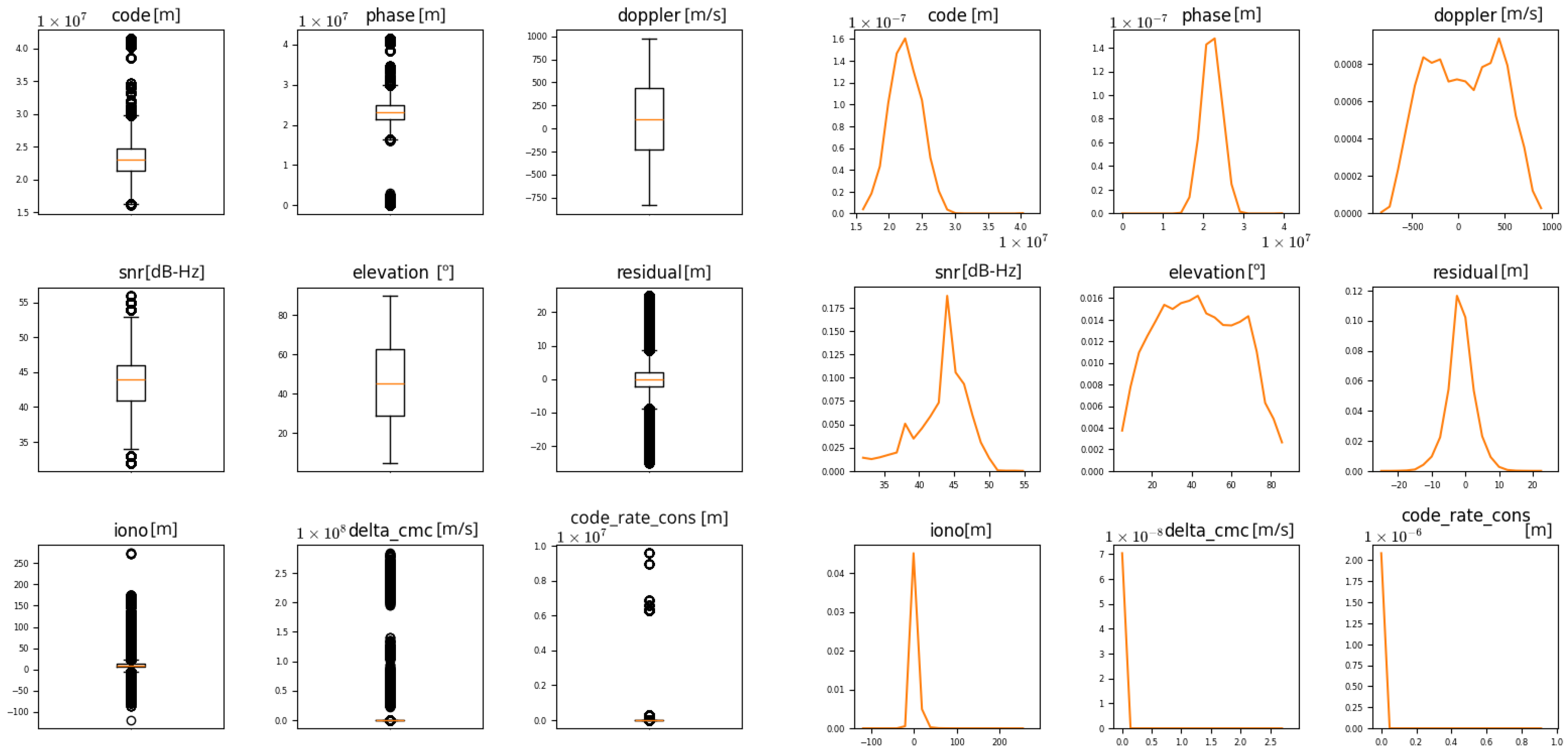
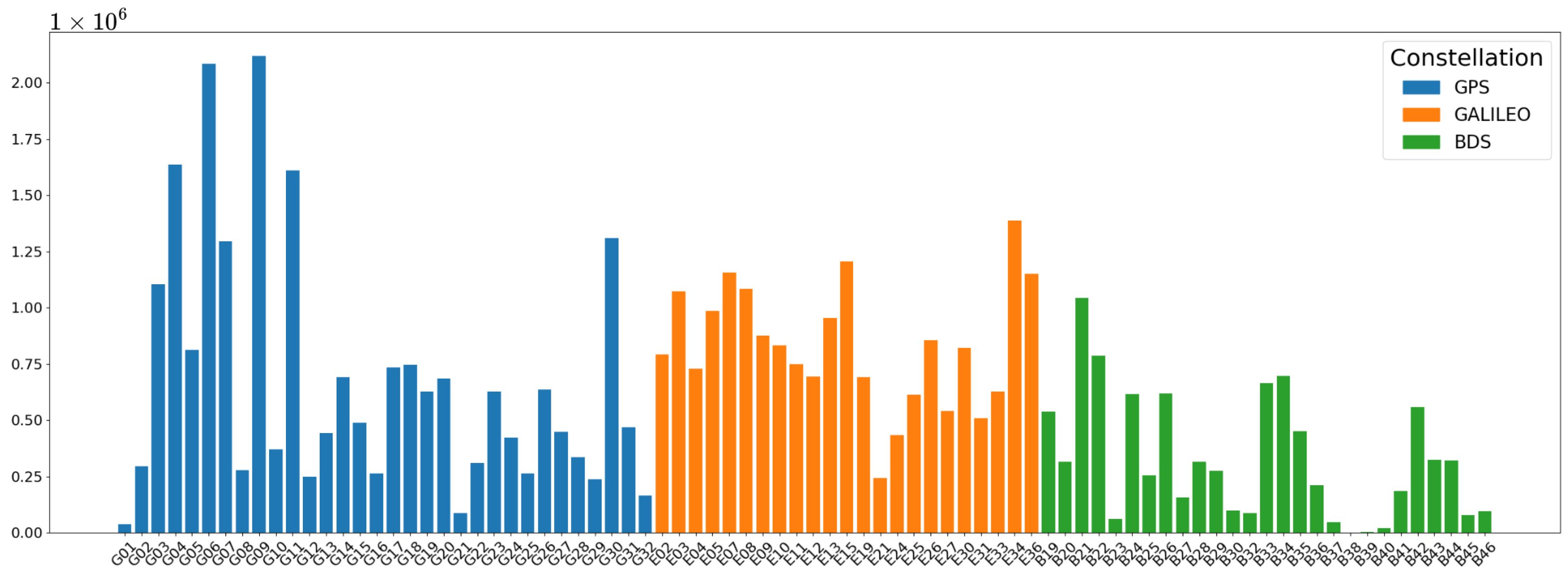
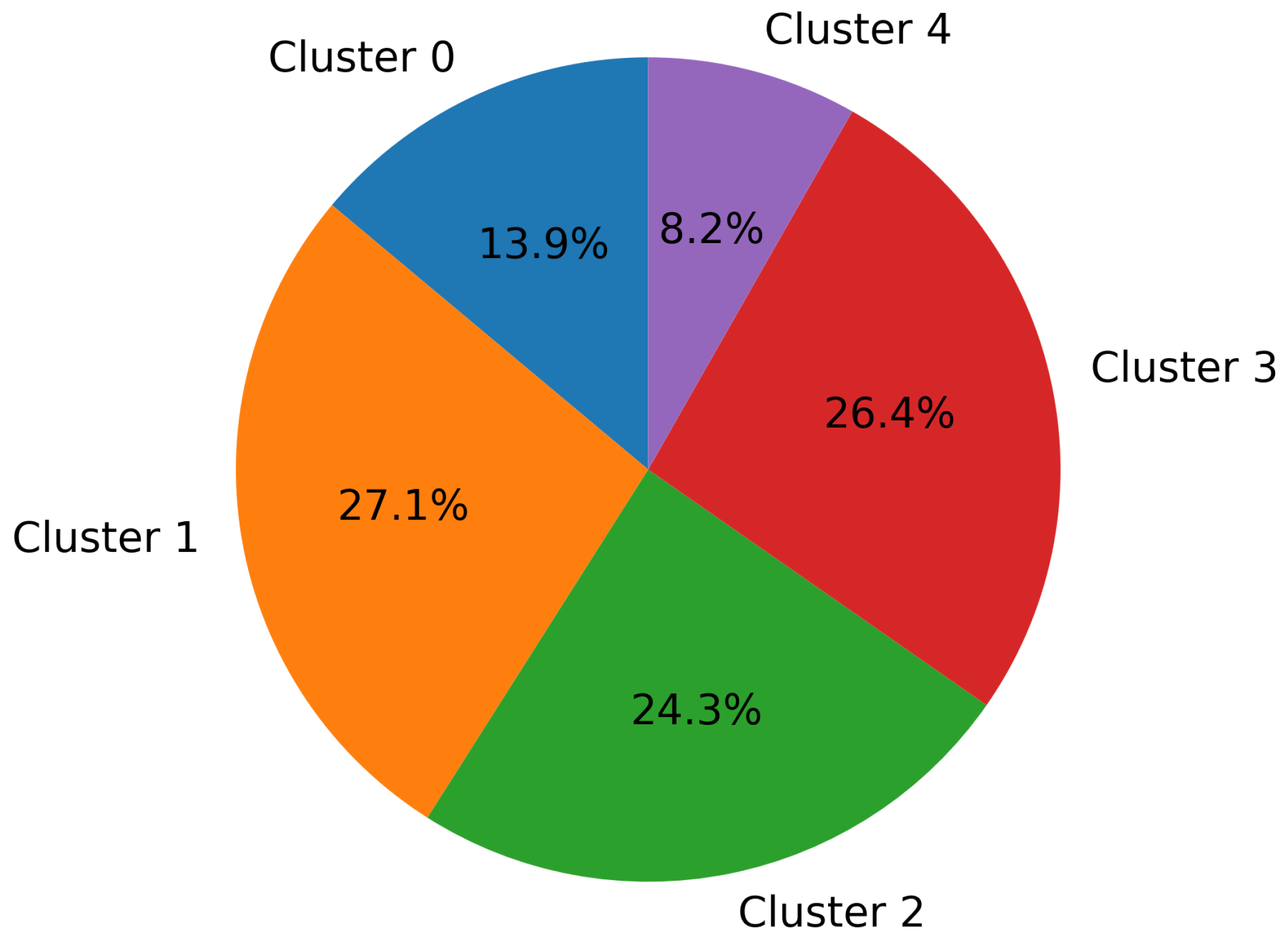
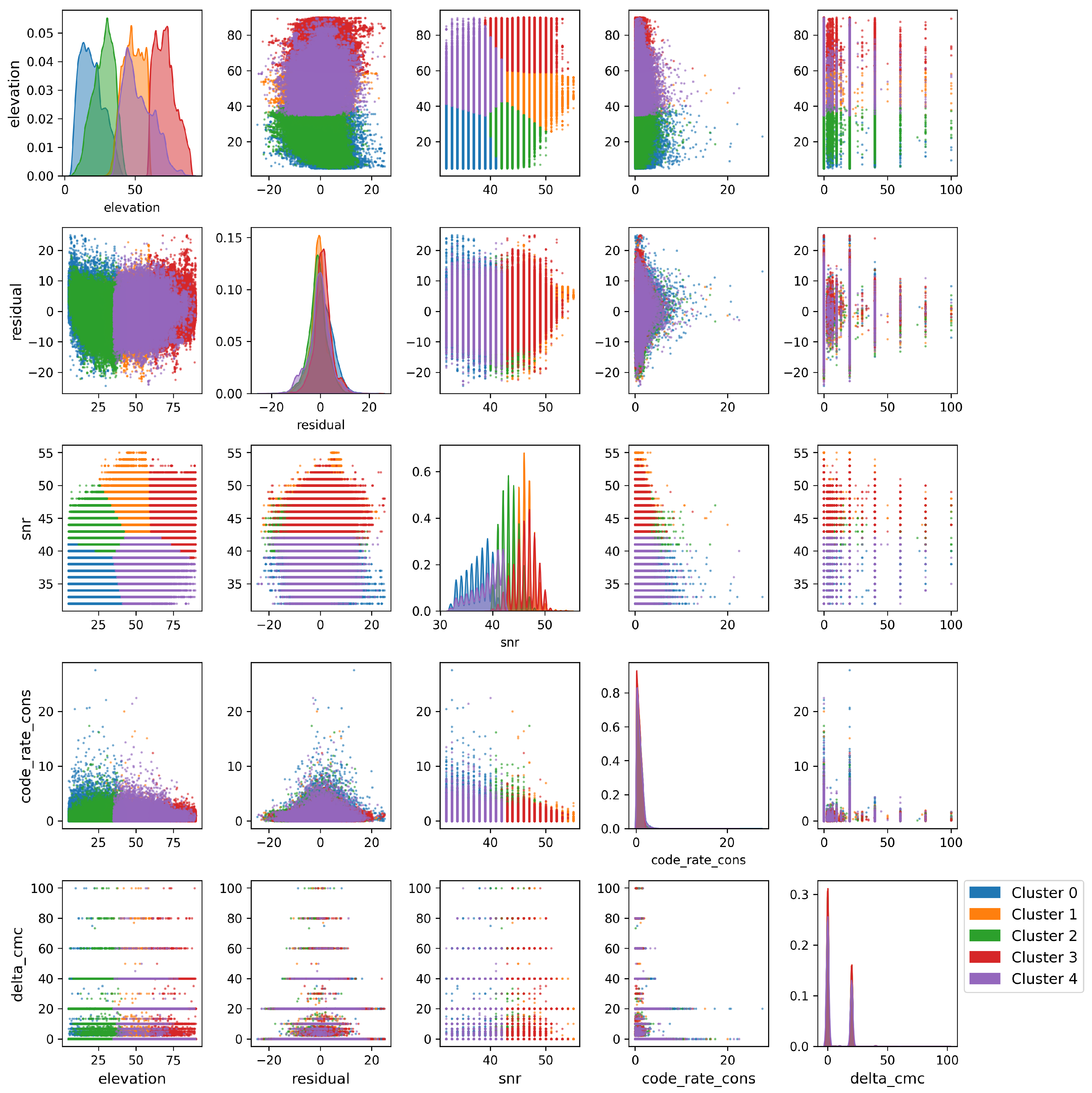
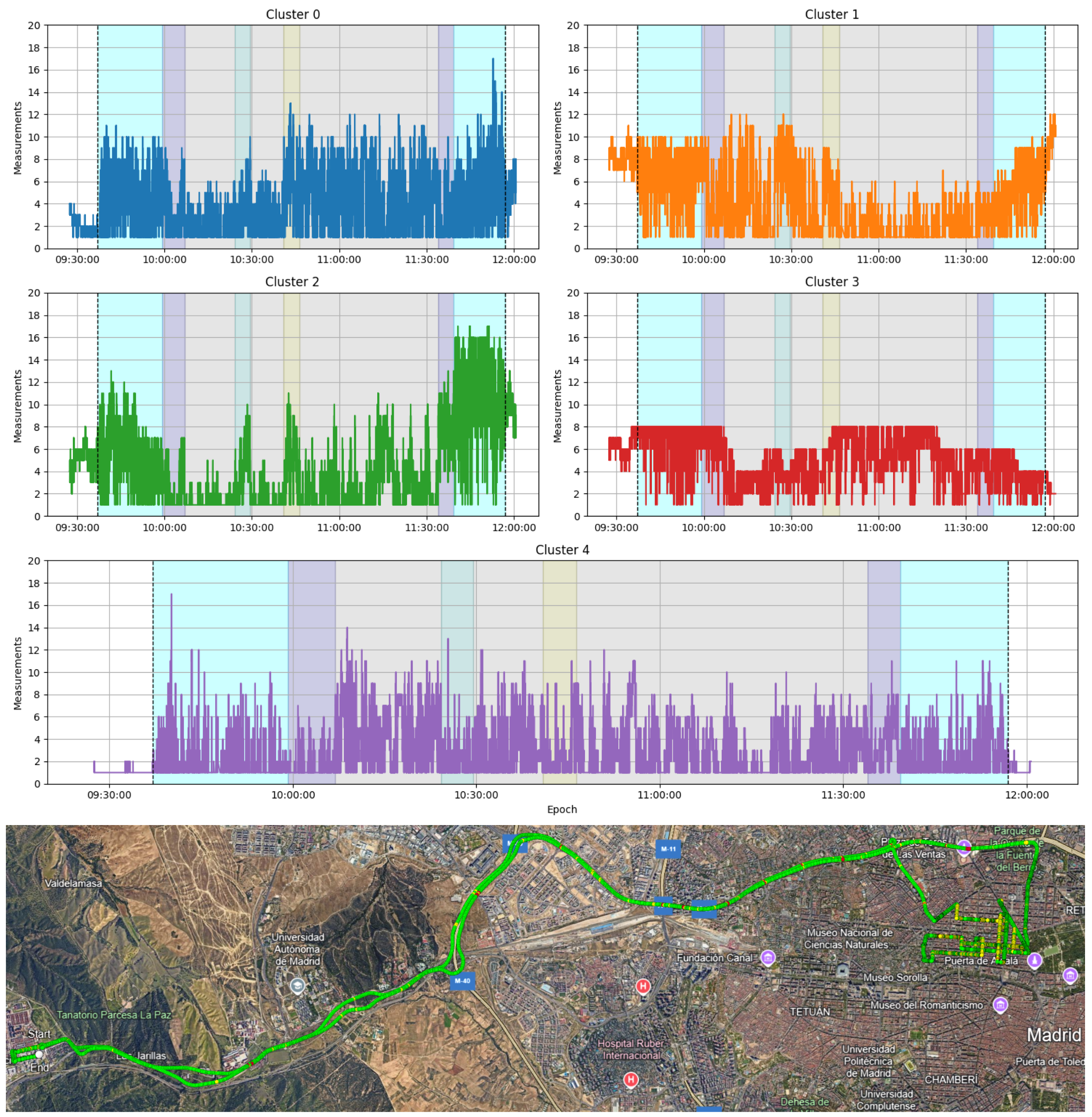
| Number of Clusters | CHI | DBI | Silhouette Coefficient |
|---|---|---|---|
| 2 Clusters | 58,711,400 | 0.999 | 0.457 |
| 3 Clusters | 92,425,300 | 0.917 | 0.380 |
| 4 Clusters | 93,903,700 | 0.963 | 0.357 |
| 5 Clusters | 90,250,400 | 0.836 | 0.368 |
| 6 Clusters | 83,099,200 | 0.925 | 0.325 |
Disclaimer/Publisher’s Note: The statements, opinions and data contained in all publications are solely those of the individual author(s) and contributor(s) and not of MDPI and/or the editor(s). MDPI and/or the editor(s) disclaim responsibility for any injury to people or property resulting from any ideas, methods, instructions or products referred to in the content. |
© 2025 by the authors. Licensee MDPI, Basel, Switzerland. This article is an open access article distributed under the terms and conditions of the Creative Commons Attribution (CC BY) license (https://creativecommons.org/licenses/by/4.0/).
Share and Cite
Tena, Á.; Chamorro, A.; Calle, J.D. Enhancing GNSS PPP Algorithms with AI: Towards Mitigating Multipath Effects. Eng. Proc. 2025, 88, 56. https://doi.org/10.3390/engproc2025088056
Tena Á, Chamorro A, Calle JD. Enhancing GNSS PPP Algorithms with AI: Towards Mitigating Multipath Effects. Engineering Proceedings. 2025; 88(1):56. https://doi.org/10.3390/engproc2025088056
Chicago/Turabian StyleTena, Álvaro, Adrián Chamorro, and Jesús David Calle. 2025. "Enhancing GNSS PPP Algorithms with AI: Towards Mitigating Multipath Effects" Engineering Proceedings 88, no. 1: 56. https://doi.org/10.3390/engproc2025088056
APA StyleTena, Á., Chamorro, A., & Calle, J. D. (2025). Enhancing GNSS PPP Algorithms with AI: Towards Mitigating Multipath Effects. Engineering Proceedings, 88(1), 56. https://doi.org/10.3390/engproc2025088056






